
|


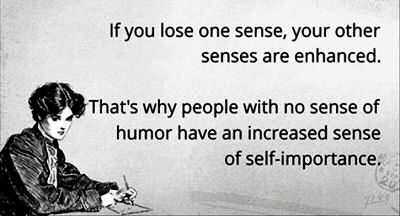
"All sensation is true;
sensation is the
primary source of knowledge."
Epicurus
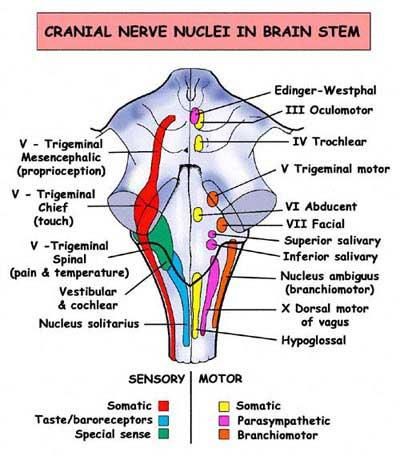
There is evidence that
cannabinoid-based medicines that are selective for different targets in the
cannabinoid signalling system (e.g. receptors, inactivation mechanism, enzymes)
might be beneficial in basal ganglia disorders, namely
Parkinson' disease and
Huntington' disease.
These benefits not only include the
alleviation of specific motor symptoms [e.g. choreic movements with cannabinoid
receptor type 1 (CB1)/transient receptor potential vanilloid type 1
agonists in Huntington' disease;
bradykinesia with
CB1 antagonists and
tremor with
CB1 agonists in Parkinson' disease, but also
the delay of disease progression due to the neuroprotective properties
demonstrated for cannabinoids (e.g. CB1 agonists reduce
excitotoxicity; CB2 agonists limit the toxicity of reactive
microglia; and antioxidant
cannabinoids attenuate oxidative damage).
Endocannabinoid ligands,
their synthesizing and degrading enzymes, and their receptors are particularly
abundant in basal ganglia structures. |
Amyotrophic Lateral
Sclerosis (ALS) is a
neurodegenerative condition characterised by the selective loss of motor
neurons from the spinal cord, brainstem and motor cortex.
Although the
pathogenic mechanisms that underlie ALS are not yet fully understood, there is
significant evidence that several neurotoxic mechanisms including
excitotoxicity, inflammation and oxidative stress, all contribute to disease
pathogenesis.
Although primarily a motor neuron specific disorder, ALS
is not cell-autonomous and non-neuronal cells including astroglia and microglia
play a critical role in mechanism of disease.
Currently the only
licensed therapy available for the treatment of ALS is the anti-glutamatergic
agent Riluzole has limited therapeutic effects.
However, there is
increasing evidence that cannabinoids and manipulation of the endocannabinoid
system may have therapeutic value in ALS, in addition to other
neurodegenerative conditions.
Cannabinoids exert anti-glutamatergic and
anti-inflammatory
actions through activation of the CB(1) and CB(2) receptors, respectively.
Activation of CB(1) receptors may therefore inhibit glutamate release from
presynaptic nerve terminals and reduce the postsynaptic calcium influx in
response to glutamate receptor stimulation.
Meanwhile, CB(2) receptors
may influence inflammation, whereby receptor activation reduces microglial
activation, resulting in a decrease in microglial secretion of neurotoxic
mediators.
Finally, cannabinoid agents may also exert anti-oxidant
actions by a receptor-independent mechanism.
Therefore the ability of
cannabinoids to target multiple neurotoxic pathways in different cell
populations may increase their therapeutic potential in the treatment of ALS.
|
sense is defined
as:to
grasp;
to perceive;
to understand;
good judgement;
moral apprehension
natural
apprehension
complying with
consensus;
a
general conscious awareness;
a sensation produced by a
stimulus;
an
intuitive acquired ability to estimate;
the normal ability to think or
reason soundly;
to become aware of; meaning;
import; significance;
intellectual
perception;
apperception;
recognition;
discernment.
Any of the faculties by which stimuli from outside or inside the
body are received and felt, as the faculties of hearing, sight, smell, touch,
taste, and equilibrium.
Sense is
the mind acting in the direct
cognition of material objects or of
its own mental states.
Understanding is the logical power of apprehending
general conceptions while
classifying, arranging, and making deductions.
Reason is
the power of apprehending
fundamental truths which are the conditions of
all real and scientific
knowledge, and which control
the mind in all its processes of investigation and
deduction.
nine major sense
groups
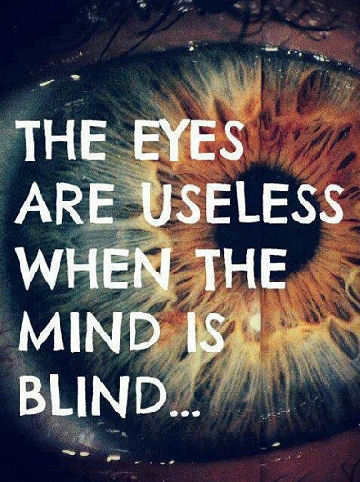
"Visually most of us can immediately perceive
only four or so items."
Samuel Arbesman
sight

"He who smells, gets
hungry;
he who smells not,
desires Monsanto."

"He who touches, feels;
he who touches not,
feels not."

taste
"He who tastes, knows bitterness, saltiness and
sourness;
he who tastes not, knows only
the flavor of HFCS."

hearing
Recent studies show the
cSlo gene uses alternative splicing to create
576 different
proteins, each with a slightly different response.
Observers of
hair cells on one end of the cochlea found a protein.
Looked at the
hair cells on the other end, they found another protein.
In between,
they found 574 other proteins, each of which was ideal for producing a strong
response to a specific sound frequency!
In other words, the exons and introns of the cSlo gene have been set up
so that each hair cell can use alternative splicing to produce a protein
perfect for the frequencie to which it responds most strongly!
The
design is so detailed that each
cochlea hair cell chooses from among 576 different protein expressions in order
to acheive resonance.
Douglas L. Black, "Splicing in the Inner
Ear: a Familiar Tune, but What Are the Instruments?"; Neuron
20:165–168, 1998 |

intuition

equilibrium
"He who is in balance, walks a straight
line;
he who is not in balance, falls down."
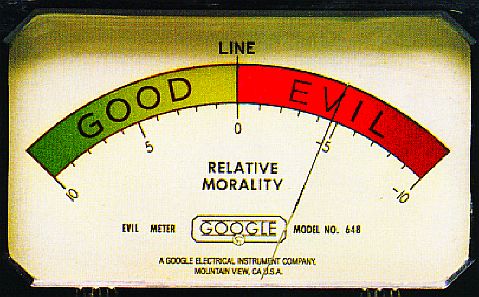

"Our senses are limited.
We 'see' only some
wavelengths of light
;
we 'smell' only a range of odours;
we 'hear' only a range
of sounds.
If we see nothing, then this does not mean that nothing is
there.
The extents of our senses, both quantitatively and
qualitatively, are also the results of an
adaptive selection process that must
allocate scarce resources.
We could have evolved eyes that were
thousands of times more sensitive, but that ability would need to have been
paid for by using resources that could have been used elsewhere.
We
have ended up with a package of senses that makes efficient use of the
scarce resources available." -
John D. Barrow

Although human senses are
limited they are truly quite magnificent.
A human with normally functioning senses
can;
feel on the fingertips or face a pressure that depresses the skin a
.00004 inch,
feel the
weight of a bee's wing falling on the cheek from less than half an inch
away,
see a small candle flame from 30 miles away on
a clear, dark night,
distinguish among
more than 300,000 different color
variations,
smell one drop of perfume diffused through a three-room
apartment,
taste .04 ounce-of table salt dissolved in 530 quarts of
water,
gauge the direction of a sound's origin based on a .00003 second
difference in its arrival from one ear to
the other.
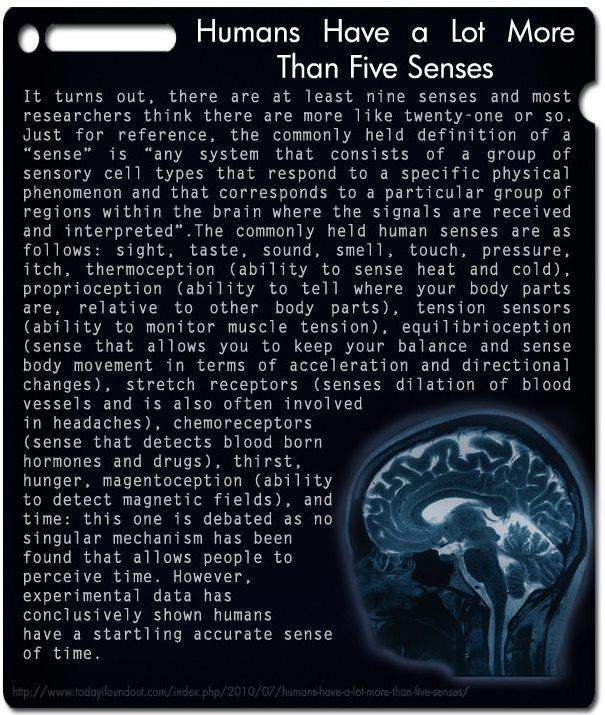
The commonly held definition of a "sense" is "any system that
consists of a group of sensory cell types that respond to a specific physical
phenomenon and that corresponds to a particular group of regions within the
brain where the signals are received and interpreted.
The commonly held
human senses are as follows:
Sight:
This
technically is two senses given the two distinct types of receptors present,
one for color (cones) and one for brightness (rods).
Taste:
This is sometimes argued to be five senses by
itself due to the differing types of taste receptors (sweet, salty, sour,
bitter, and umami), but
generally is just referred to as one sense. For those who don't know,
umami receptors detect the amino
acid glutamate, which is a taste generally found in
meat and some
artificial flavoring. The
taste sense, unlike sight, is a sense based on a chemical reaction
Touch:
This has been found to be
distinct from pressure, temperature, pain, and even itch sensors.
Pressure:
Obvious sense is obvious. ;-)
Itch:
Surprisingly, this is a distinct sensor system
from other touch-related senses.
Thermoception:
Ability to sense heat and cold. This
also is thought of as more than one sense. This is not just because of the two
hot/cold receptors, but also because there is a completely different type of
thermoceptor, in terms of the mechanism for detection, in the brain. These
thermoceptors in the brain are used for
monitoring internal body
temperature.
Sound:
Detecting
vibrations along some medium, such as air or water that is in contact with your
ear drums. Smell: Yet another of the sensors that work off of a chemical
reaction. This sense combines with taste to produce flavors.
Proprioception:
This sense gives you the ability to tell where your body parts are,
relative to other body parts.
This sense is one of the things
police officers test
when they pull over someone who they think is driving drunk. The "close your
eyes and touch your nose" test is testing this sense.
This sense is
used all the time in little ways, such as when you scratch an itch on your
foot, but never once look at your foot to see where your hand is relative to
your foot.
Tension Sensors:
These are
found in such places as your muscles and allow the brain the ability to monitor
muscle tension.
Nociception:
In a word, pain. This was once thought to simply be the result of
overloading other senses, such as "touch", but this has been found not to be
the case and instead, it is its own
unique sensory system. There are three distinct types of pain receptors:
cutaneous (skin), somatic (bones and joints), and visceral (body
organs).
Evaluation of
Prevalent Phytocannabinoids in the Acetic Acid Model of Visceral
Nociception
Cannabidiol (CBD), cannabinol (CBN), and cannabichromene
(CBC) elicit antinociceptive effects in some assays. In contrast,
tetrahydrocannabivarin (THCV), another component of cannabis, antagonizes the
pharmacological effects of Δ9THC. These results suggest that
various constituents of this plant may interact in a complex manner to modulate
pain.

Magentoception:
This is the ability to detect
magnetic fields,
which is principally useful in providing a sense of direction when detecting
the magnetic field of the
Earth. Unlike most birds, humans
do not have a strong magentoception, however, experiments have demonstrated
that we do tend to have some
sense of magnetic fields. The mechanism for this is not completely
understood; it is theorized that this has something to do with deposits of iron
oxide in our noses. This would make sense if that is correct as
humans who are given magnetic
implants have been shown to have a much stronger magnetoception than humans
without.
Equilibrioception:
The sense
that allows you to keep your balance and sense body movement in terms of
acceleration and directional changes. This sense also allows for perceiving
gravity. The sensory system for this is found in your inner ears and is called
the vestibular labyrinthine system. Anyone who's ever had this sense go out on
them on occasion knows how important this is. When it's not working or
malfunctioning, you literally can't tell up from down and moving from one
location to another without aid is nearly impossible.
Stretch Receptors:
These are found in such places as
the lungs, bladder, stomach, and the gastrointestinal tract. A type of stretch
receptor, that senses dilation of blood vessels,
is also often involved in headaches.
Chemoreceptors:
These trigger an area of the medulla
in the brain that is involved in detecting
blood born hormones and
drugs. It also is involved in the vomiting reflex.
Thirst:
This system more or less allows your body to
monitor its hydration level and so your body knows when it should tell you to
drink.
Hunger:
This system allows your
body to detect when you need to eat
something.
Time:
This one is debated
as no singular mechanism has been found that allows people to perceive time.
However, experimental data has conclusively shown humans have a startling
accurate sense of time, particularly when younger. The mechanism we use for
this seems to be a distributed system involving
the cerebral cortex,
cerebellum, and basal
ganglia. Long term time keeping seems to be monitored by the suprachiasmatic
nuclei (responsible for the circadian rhythm). Short term time keeping is
handled by other cell systems.
Did you know humans have the ability to
ignore one or more of the sensory systems at any given time ? |
|

 |
This web site is not a commercial web site and
is presented for educational purposes only.

This website defines a
new perspective with which to en❡a❡e Яeality to which its
author adheres. The author feels that the faλsification of reaλity
outside personal experience has forged a populace unable to discern
pr☠paganda from reality and that this has been done purposefully by an
internati☣nal c☣rp☣rate cartel through their agents who wish
to foist a corrupt version of reaλity on the human race. Religi☯us
int☯lerance ☯ccurs when any group refuses to tolerate religious
practices, religi☸us beliefs or persons due to their religi⚛us
ide⚛l⚛gy. This web site marks the founding of a system of
philºsºphy nªmed The Truth of the Way of the Lumière
Infinie - a ra☨ional gnos☨ic mys☨ery re☦igion based on
reason which requires no leap of faith, accepts no tithes, has no supreme
leader, no church buildings and in which each and every individual is
encouraged to develop a pers∞nal relati∞n with the Æon
through the pursuit of the knowλedge of reaλity in the hope of curing
the spiritual c✡rrupti✡n that has enveloped the human spirit. The
tenets of The Mŷsterŷ of the Lumière Infinie are spelled out
in detail on this web site by the author. Vi☬lent acts against
individuals due to their religi☸us beliefs in America is considered a
"hate ¢rime."
This web site in no way c☬nd☬nes
vi☬lence. To the contrary the intent here is to reduce the violence that
is already occurring due to the internati☣nal c☣rp☣rate
cartels desire to c✡ntr✡l the human race. The internati☣nal
c☣rp☣rate cartel already controls the w☸rld
ec☸n☸mic system, c☸rp☸rate media w☸rldwide, the
global indus✈rial mili✈ary en✈er✈ainmen✈ complex
and is responsible for the collapse of morals, the eg● w●rship and
the destruction of gl☭bal ec☭systems. Civilization is based on
coöperation. Coöperation with bi☣hazards of a
gun.
American social mores and values have declined precipitously over
the last century as the corrupt international cartel has garnered more and more
power. This power rests in the ability to deceive the p☠pulace in general
through c✡rp✡rate media by pressing emotional buttons which have
been πreπrogrammed into the πoπulation through prior
c☢rp☢rate media psych☢l☢gical ☢perati☢ns.
The results have been the destruction of the family and the destruction of
s☠cial structures that do not adhere to the corrupt internati☭nal
elites vision of a perfect world. Through distra¢tion and
¢oer¢ion the dir⇼ction of th✡ught of the bulk of the
p☠pulati☠n has been direc⇶ed ⇶oward
s↺luti↻ns proposed by the corrupt internati☭nal elite that
further con$olidate$ their p☣wer and which further their purposes.
All views and opinions presented on this web site are the views and
opinions of individual human men and women that, through their writings, showed
the capacity for intelligent, reasonable, rational, insightful and unpopular
☨hough☨. All factual information presented on this web site is
believed to be true and accurate and is presented as originally presented in
print media which may or may not have originally presented the facts
truthfully. Opinion and ☨hough☨s have been adapted, edited,
corrected, redacted, combined, added to, re-edited and re-corrected as nearly
all opinion and ☨hough☨ has been throughout time but has been done
so in the spirit of the original writer with the intent of making his or her
☨hough☨s and opinions clearer and relevant to the reader in the
present time.
Fair Use Notice

This site may contain
copyrighted material the use of which has not always been specifically
authorized by the copyright owner. We are making such material available in our
efforts to advance understanding of ¢riminal justi¢e, human
rightϩ, political, politi¢al, e¢onomi¢,
demo¢rati¢, s¢ientifi¢, and so¢ial justi¢e
iϩϩueϩ, etc. We believe this constitutes a 'fair use' of any
such copyrighted material as provided for in section 107 of the US Copyright
Law. In accordance with Title 17 U.S.C. Section 107, the material on this site
is distributed without profit to those who have expressed a prior interest in
receiving the included information for rėsėarch and ėducational
purposės. For more information see:
www.law.cornell.edu/uscode/17/107.shtml. If you wish to use copyrighted
material from this site for purposes of your own that go beyond 'fair use', you
must obtain permission from the copyright owner. |
 Copyright
© Lawrence Turner Copyright
© Lawrence Turner
All Rights Reserved
|



















